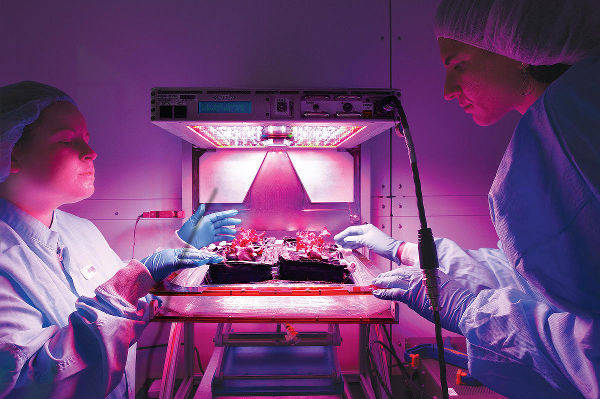Space-grown lettuce turned out to be not only safe to eat, but also nutrient-rich and delicious

In the universe where gravity is lower than the earth and there is more radiation, there are a number of problems for humans to survive, but there is also a point at the research stage where 'can vegetables grow safe to eat in space?' . Meanwhile, new announcements by researchers have shown that red romaine lettuce grown in space is 'fresh, delicious, nutritious, and safe to eat.'
Frontiers | Microbiological and Nutritional Analysis of Lettuce Crops Grown on the International Space Station | Plant Science
https://www.frontiersin.org/articles/10.3389/fpls.2020.00199/full
Space-grown lettuce is safe to eat, says study.Delicious, say astronauts-CNN
https://edition.cnn.com/2020/03/06/world/space-lettuce-iss-scn/index.html
As food cannot be cooked in space and food fragments can splatter in the spacecraft and cause failures, astronauts' meals are mainly retorted and packaged. However, because food reserves can affect flight distances, it is believed that a future “earth-independent” food cycle is needed.
For this reason, NASA started self-cultivation of vegetables in space in 2013. As of 2020, three types of lettuce, as well as Chinese cabbage, mizuna, kale, and zinnia are grown. This space cultivation project is called 'VEGGIE'.
Vegetable cultivation project in space `` VEGGIE '' promoted by NASA-gigazine

However, the environment is too different between the earth and space, so when we started the project, it was unclear whether vegetables would grow safely and whether humans could eat them. Then, in 2014, the first harvested lettuce will be frozen and sent to the Kennedy Space Center. Scientists have shown that lettuce is safe.
After it turns out that it is safe to eat, you can see the astronauts eating lettuce inside the ship from the video below.
Astronauts Take First Bites of Space-Grown Lettuce-YouTube
After that, researchers further analyzed red romaine lettuce harvested from 2014 to 2016, and newly found that `` space-cultivated lettuce is not only safe and free of bacteria that cause disease, but also nutritionally. It is almost the same as lettuce grown on earth. '
So far, NASA's concern about crops in space has been the effects of radiation on plants. The researchers reproduced the environment at the Kennedy Space Center under the same conditions as temperature, carbon dioxide, and humidity recorded at the space station for comparison with space vegetables. As a result of the cultivation at two locations, it was found that vegetables grew in space for 33-56 days, and that Earth's vegetables grew 24-72 hours later. Also, the amount of potassium, sodium, phosphorus, sulfur, and zinc contained in vegetables is larger for space vegetables than for earth vegetables. Space vegetables also contain more phenols that are reported in tomatoes and apples and have reported anti-inflammatory, anti-cancer and anti-viral effects.
In addition, observations of the leaves and roots of the space lettuce revealed microorganisms similar to lettuce grown on Earth. The findings are unexpected because the space station has its own microorganisms. On the other hand, Escherichia coli, Salmonella, Staphylococcus aureus, etc., which are human pathogens, were not detected.
Normally, processed foods eaten by astronauts are deficient in nutrients such as potassium, vitamin C, vitamin B1, and vitamin K, and the food itself deteriorates after the processing time. Self-cultivation in space therefore solves this problem and clears one long-term mission to the Moon and Mars. Researchers are willing to experiment with fruits such as tomatoes and peppers in addition to other leafy vegetables in the future.
Related Posts:







